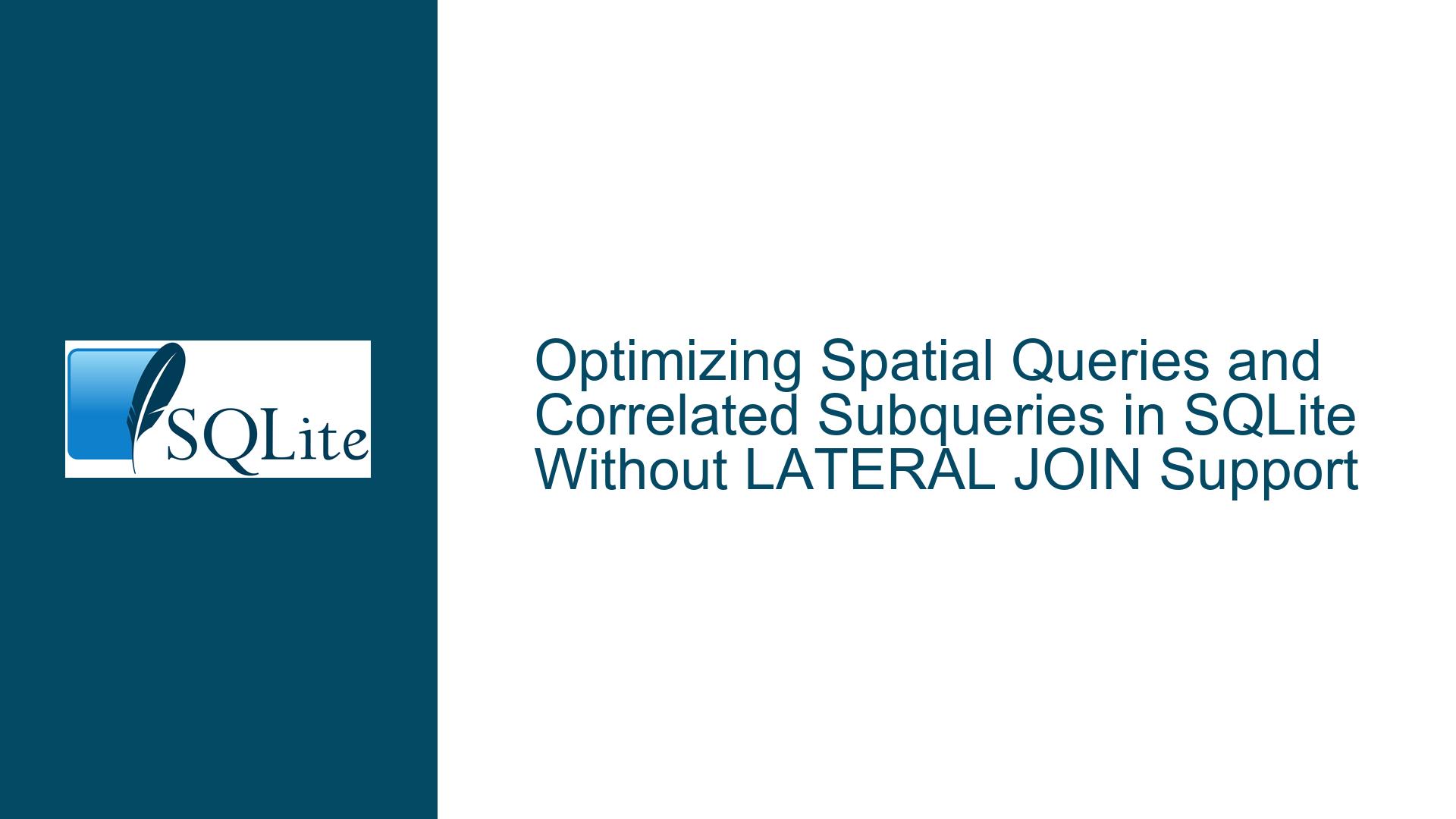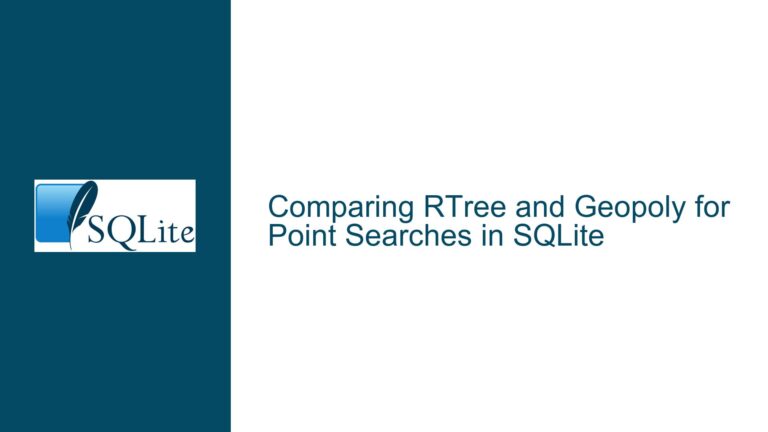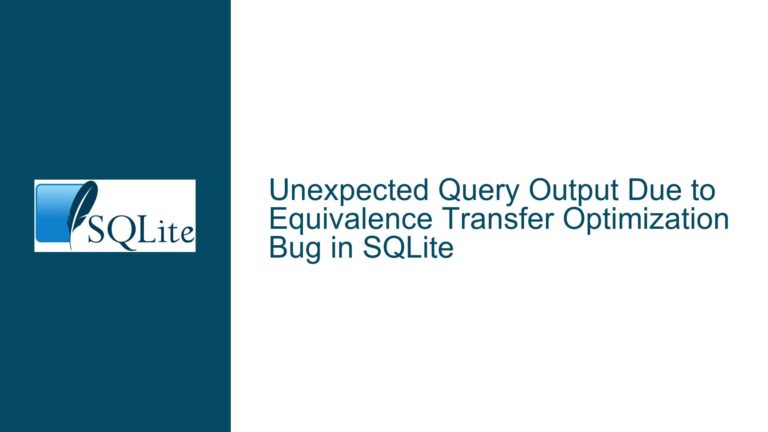Optimizing Spatial Queries and Correlated Subqueries in SQLite Without LATERAL JOIN Support
Spatial Query Performance Degradation with Correlated Subqueries
The core challenge involves executing spatial nearest-neighbor queries across two tables (e.g., buildings and fire hydrants) while retrieving multiple columns or rows from the joined table. A typical use case requires finding the three closest hydrants for each building, including their IDs and distances. In PostgreSQL, this is elegantly solved with LATERAL JOIN, which allows the subquery to reference columns from the outer query and efficiently limit results per row. However, SQLite’s lack of native LATERAL JOIN support forces developers to use correlated subqueries that trigger full Cartesian product evaluations. This approach becomes computationally prohibitive as dataset sizes grow, with time complexity scaling as O(N × M) for N buildings and M hydrants.
The problem manifests in two specific ways:
- Single-Value Limitation: Correlated subqueries in SQLite can only return scalar values, making it impossible to retrieve multiple columns (e.g., hydrant ID and distance) or multiple rows (e.g., top three nearest hydrants) in a single query.
- Cartesian Product Overhead: Even when attempting to work around this limitation by nesting subqueries or using
LIMIT, the optimizer evaluates the entire cross-join between tables before applying filters, leading to unnecessary computation.
In the provided example, a query for the nearest hydrant’s ID fails with an error (no such column: nyc_footprints_mp_1000.geometry) due to scope limitations in correlated subqueries. Meanwhile, the PostgreSQL equivalent using LATERAL JOIN successfully returns three hydrants per building with their IDs and distances, demonstrating the need for a similar mechanism in SQLite.
Architectural Constraints and Query Execution Inefficiencies
1. Correlated Subquery Mechanics in SQLite
Correlated subqueries are re-evaluated for every row in the outer query. For spatial queries involving geometric distance calculations, this forces a full scan of the hydrant table for each building. With N=1,000 buildings and M=100 hydrants, the ST_DISTANCE function is called 100,000 times. While manageable at this scale, real-world datasets (N=1,000,000, M=100,000) would require 100 billion computations, rendering the approach impractical.
2. Absence of LATERAL JOIN Semantics
SQLite’s join operations are static and do not allow the right-hand side of a join to reference columns from the left-hand side during the same query phase. This prevents the optimizer from "pushing down" predicates into the subquery or using index-driven lookups based on the outer query’s current row. The result is that spatial queries cannot leverage spatial indexes (e.g., R-Trees) effectively when using subqueries.
3. SpatiaLite’s Index Utilization Challenges
While SpatiaLite extends SQLite with spatial functions and R-Tree indexes, these are underutilized in correlated subqueries. The ST_DISTANCE function operates on raw geometry blobs, bypassing spatial indexes unless explicitly wrapped with index-aware operators like <-> (PostgreSQL’s distance operator). SpatiaLite lacks an equivalent optimization, forcing brute-force distance calculations even when indexed.
4. Result Set Cardinality Mismatch
SQLite’s scalar subqueries cannot return multiple rows, necessitating separate queries for each desired hydrant (e.g., 1st, 2nd, and 3rd nearest). This triples the number of subquery executions and complicates result consolidation.
Workarounds, Optimizations, and Future Solutions
1. Temporary Tables with Precomputed Distances
For small to medium datasets, precompute all pairwise distances and store them in a temporary table:
CREATE TEMP TABLE building_hydrant_distances AS
SELECT
b.ogc_fid AS building_id,
h.ogc_fid AS hydrant_id,
ST_DISTANCE(b.geometry, h.geometry) AS distance
FROM
nyc_building_footprints_mp_1000 AS b
CROSS JOIN nyc_fire_hydrants_100 AS h;
-- Query for top 3 hydrants per building
SELECT * FROM (
SELECT
building_id,
hydrant_id,
distance,
ROW_NUMBER() OVER (PARTITION BY building_id ORDER BY distance) AS rank
FROM building_hydrant_distances
) WHERE rank <= 3;
Pros: Avoids repetitive distance calculations.
Cons: Temporary table storage scales as O(N × M); impractical for large datasets.
2. Window Functions with Filtered Joins
Use a Common Table Expression (CTE) to compute distances and rank results in a single pass:
WITH ranked_hydrants AS (
SELECT
b.ogc_fid AS building_id,
h.ogc_fid AS hydrant_id,
ST_DISTANCE(b.geometry, h.geometry) AS distance,
ROW_NUMBER() OVER (
PARTITION BY b.ogc_fid
ORDER BY ST_DISTANCE(b.geometry, h.geometry)
) AS rank
FROM
nyc_building_footprints_mp_1000 AS b
CROSS JOIN nyc_fire_hydrants_100 AS h
)
SELECT building_id, hydrant_id, distance
FROM ranked_hydrants
WHERE rank <= 3;
Pros: Single query without temporary tables.
Cons: Still computes all N × M distances; no index utilization.
3. Spatial Index-Driven Approximations
SpatiaLite’s R-Tree indexes can accelerate bounding-box comparisons, reducing the number of precise distance calculations:
SELECT
b.ogc_fid AS building_id,
h.ogc_fid AS hydrant_id,
MIN(ST_DISTANCE(b.geometry, h.geometry)) AS distance
FROM
nyc_building_footprints_mp_1000 AS b
JOIN SpatialIndex AS si
ON si.f_table_name = 'nyc_fire_hydrants_100'
JOIN nyc_fire_hydrants_100 AS h
ON h.ogc_fid = si.pkid
WHERE
si.minX <= ST_MaxX(b.geometry) + 0.02 -- Search radius adjustment
AND si.maxX >= ST_MinX(b.geometry) - 0.02
AND si.minY <= ST_MaxY(b.geometry) + 0.02
AND si.maxY >= ST_MinY(b.geometry) - 0.02
GROUP BY b.ogc_fid
ORDER BY distance
LIMIT 3;
Pros: Reduces the number of hydrants considered per building using index filters.
Cons: Requires manual tuning of search radii; inexact results.
4. Application-Side Batching
For very large datasets, offload the correlation logic to the application:
- Retrieve all buildings.
- For each building, execute a parameterized query to find the nearest hydrants:
SELECT
ogc_fid AS hydrant_id,
ST_DISTANCE(?, geometry) AS distance
FROM nyc_fire_hydrants_100
ORDER BY distance
LIMIT 3;
- Bind each building’s geometry as a parameter.
Pros: Full control over indexing and parallelization.
Cons: Increased network roundtrips; complexity in managing batches.
5. User-Defined Functions for Index-Aware Distance
Extend SpatiaLite with a custom function that leverages R-Tree indexes:
#include <sqlite3.h>
#include <spatialite.h>
void spatialite_distance_udf(
sqlite3_context *context,
int argc,
sqlite3_value **argv
) {
// Pseudocode: Use R-Tree to find nearby hydrants first
// Compute exact distances only for candidates
// Return sorted results
}
// Register the UDF in SpatiaLite
sqlite3_create_function_v2(
db, "INDEX_AWARE_DISTANCE", 2,
SQLITE_UTF8, NULL,
&spatialite_distance_udf, NULL, NULL, NULL
);
Pros: Combines index efficiency with precise calculations.
Cons: Requires C/C++ programming and recompiling SpatiaLite.
6. Experimental LATERAL JOIN Branch
As hinted in the discussion, SQLite’s lateral-join branch introduces experimental support. Developers willing to compile from source can test:
SELECT
b.ogc_fid,
b.year AS constr_y,
h.hydrant_id,
h.distance
FROM
nyc_building_footprints_mp_1000 AS b
JOIN LATERAL (
SELECT
ogc_fid AS hydrant_id,
ST_DISTANCE(b.geometry, h.geometry) AS distance
FROM nyc_fire_hydrants_100 AS h
ORDER BY distance
LIMIT 3
) AS h;
Pros: PostgreSQL-like syntax and performance.
Cons: Unstable; not yet merged into mainstream SQLite.
7. SpatiaLite-Specific Optimizations
Reevaluate SpatiaLite’s configuration to ensure R-Tree indexes are fully utilized:
- Verify that spatial tables have accompanying R-Tree virtual tables.
- Use
SPATIALITE_DEBUG=1to log index usage during queries. - Prefilter hydrants using
MBRContainsorMBRWithinto reduce candidate counts.
8. Query Plan Analysis and Hints
Use EXPLAIN QUERY PLAN to diagnose missing index usage:
EXPLAIN QUERY PLAN
SELECT ... -- Original correlated subquery
If the output shows full table scans, consider:
- Adding composite indexes on geometry columns.
- Rewriting the query to isolate spatial predicates in join conditions.
Conclusion and Future Directions
While SQLite currently lacks native LATERAL JOIN support, spatial query performance can be mitigated through a combination of temporary tables, window functions, and index-aware approximations. Developers should monitor the progress of the lateral-join branch and advocate for its integration into stable releases. In the long term, tighter coupling between SQLite’s query planner and SpatiaLite’s spatial indexes could enable PostgreSQL-like efficiency without syntax changes. For now, a hybrid approach—using application-side batching for large datasets and CTEs for smaller ones—offers the most flexible path forward.






